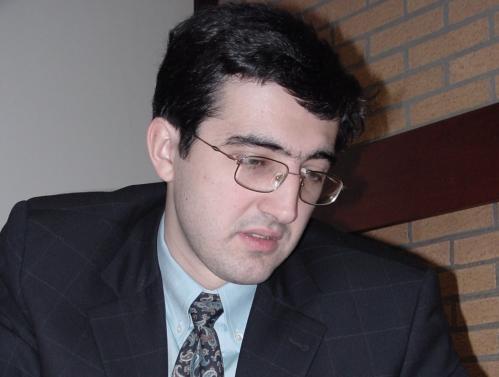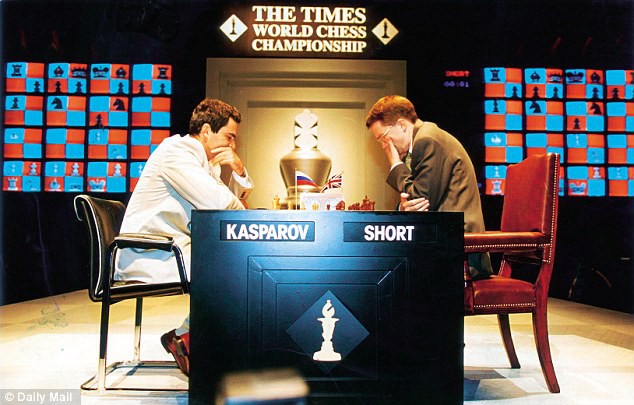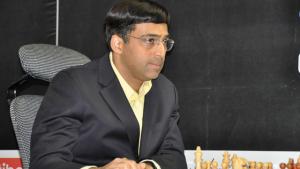
Clash of Champions: Kramnik vs. Kasparov
By 1990, Garry Kasparov had done what nobody had done before since the creation of the world championship: defended his title multiple times against the clearly best challenger. All in all, he and Anatoly Karpov played five quite grueling matches between 1984 and 1990 -- an unprecedented amount.
After the aborted first match, Kasparov won in 1985 and then a rematch in 1986. In 1987, he narrowly saved his title by drawing the match, winning "to order" in the very last game. Finally, he had a short break, but in 1990 Karpov was back, and Kasparov again won by a narrow margin, 12.5 to 11.5.
In 1993, Karpov was finally defeated before he became Kasparov's challenger, by Nigel Short. Short and Kasparov decided to leave FIDE, finding their own sponsors for the match and creating the Professional Chess Association.
As a result, FIDE stripped Kasparov of his title and ran its own world championship match between Anatoly Karpov and Jan Timman, who were the players most recently defeated by Short in the candidates matches. By winning this match, Karpov officially regained his world championship title, but -- having not defeated Kasparov in a match -- the chess world largely did not recognize him as the champion.
The match between Kasparov and Short took place in 1993, right at the moment when I was taking my first steps as a chess player. I distinctly remember the very creative play, especially by Short. However, he was not quite on Kasparov's level, and a few times he was unable to finish off some otherwise magnificent games -- Kasparov won by a score of 12.5-7.5.

Kasparov's PCA now began to run candidate matches similar to the FIDE cycle, while FIDE went ahead with its cycle as if nothing had happened. Except of course, Karpov was champion, and Kasparov and Short were absent from its rating list. Some players played in both cycles.
In 1995, the Indian grandmaster Viswanathan Anand defeated Oleg Romanishin, Michael Adams, and Gata Kamsky to qualify to face Kasparov. Again, Kasparov defeated his challenger, this time by a score of 10.5 to 7.5.
Before the beginning of the next cycle, Kasparov's PCA had collapsed, due to the loss of its main sponsor, Intel. Without funding, it was unable to hold a cycle of candidates matches as a qualifier to play Kasparov.
Thus it was decided that a match would be held between the next highest rated players to determine Kasparov's challenger. These were Anand and Vladimir Kramnik. But when Anand declined (since he was in the finals of the FIDE cycle, he could not participate in a match outside of the auspices of FIDE), the next-highest rated player, Alexei Shirov, played against Kramnik.
Shirov was an underdog in the match, but won it. However, sponsors did not materialize and the match did not take place.
Instead, two years later Kasparov -- controversially -- played Kramnik anyway in a match in London. Was it a return to the days before the second world war, when the champion picked his challenger? At least Kramnik was certainly a worthy challenger, with the world's number-two rating. But it was unquestionably an injustice to Shirov.
Kramnik was born in the town of Tuapse, Russia. As a 16-year-old he burst on the scene in the 1992 Olympiad, for which he was chosen as a reserve of the Russian team. He scored eight wins and no losses, winning a gold medal.
Soon Kramnik became one of the top players in the world -- however, like Fischer and Spassky, he suffered some setbacks on his route to the match for the world championship, losing several matches to lower-rated players (the aforementioned match with Shirov, as well as matches against Kamsky, Boris Gelfand, and Adams).

In the first game of the match, where Kramnik had the black pieces, he introduced his strategy which would play a big role in his victory. Against Kasparov's 1.e4, Kramnik used the Berlin Defense, specifically with a line that goes directly into the endgame.
Prior to the 2000 match, this line in the Berlin was hardly considered a threat to the Ruy Lopez. It was seen as a slightly worse ending where Black tries to make a draw, suitable only for endgame specialists and masochists.
However, Kramnik showed that the so-called "Berlin Wall" was not only very solid, but also very tricky. It did not take long for grandmasters to recognize its value, not just as a solid defense but also as a winning weapon.
Another big advantage of the Berlin in the modern age was that it could hardly be tackled by computer analysis. By the match with Kramnik, Kasparov was already working quite often with computer analysis, and Kramnik managed to neutralize this by his adoption of this line.
Ultimately Kasparov was unable to breach the Berlin Wall, and each queenless middlegame resulting from this ending in the match ended in a draw. Thus Kramnik neutralized Kasparov's main weapon as White, and forced him to try other openings (1.c4, for instance), where he also was unable to gain any advantage.
Meanwhile, as White, Kramnik was able to win two games, while the rest were drawn. Crucial was the second game of the match, in which Kramnik won in an opposite-bishop ending:
Of the many "queenless middlegames" played in the match, perhaps the most interesting was the one that occurred in the fourth game. Kramnik, playing a symmetrical ending from the Queen's Gambit Accepted, pushed Kasparov to the edge, obtained a winning position, but then let it slip away.
Nevertheless, Kramnik won again in the 10th game of the match, when Kasparov made a rare opening misstep and lost in only 24 moves. In fact, Kasparov was not able to win a single game, the first time since the Lasker-Capablanca match when a player did not score a win in a world championship match.
Ultimately, I think Kasparov was playing into Kramnik's hands with his opening choices in this match. Non-concrete positions such as the above ending and the Berlin Defense were ideal for Kramnik, who has a subtle positional sense.
In the one game where Kasparov nearly succeeded in winning, he did so by riskily grabbing a pawn, in a position where concrete calculation was paramount. At the time, watching the match on my computer from my college dorm room, I wanted Kasparov to retain the title because I preferred his chess style.
Behind in the match, I hoped to see a King's Indian or Benoni, but I suppose he did not trust those openings against Kramnik. Either way, the match was lost.
Despite losing the world championship title, Kasparov retained the number-one spot on the Elo list until his retirement in 2005. The hoped-for Kramnik-Kasparov rematch never happened as a result of lack of funding and various disagreements in the attempts to reunify the chess world since the 1993 split.
Kasparov, holding the world championship for 15 years in the modern era and never shrinking from battle with the top challenger, clearly had the best record as a world champion. But with the coming of the new millennium came a new group of young players and a new kind of chess in general.
Kramnik -- previously Kasparov's student -- had thus supplanted his teacher.
RELATED STUDY MATERIAL
- Read the previous article in this series, Clash of Champions: Karpov vs. Kasparov.
- Watch GM Ben Finegold's video on an exciting game between Kramnik and Caruana.
- Even super-GMs make mistakes! Learn from Kramnik's error in the Chess Mentor.
- Practice your world-championship-level combinations in the Tactics Trainer.
- Looking for articles with deeper analysis? Try our magazine: The Master's Bulletin.



